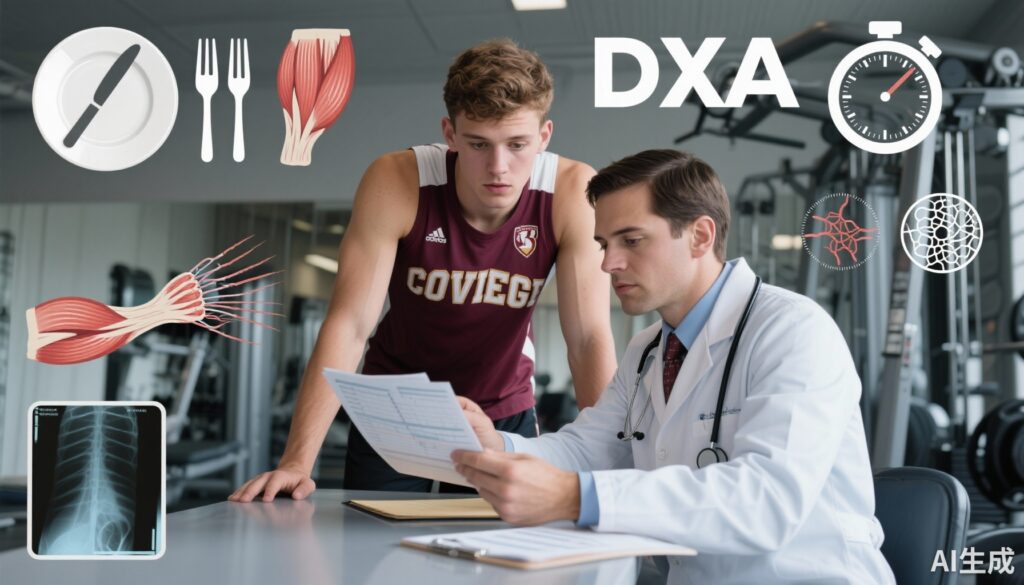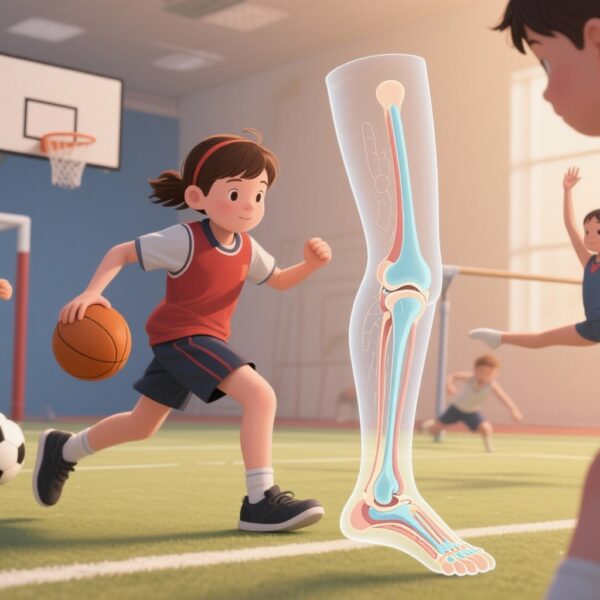Highlight
• Systematic review (DeJong Lempke et al., BJSM 2025) of 21 studies (n=536) shows LEA is frequently associated with impaired neuromusculoskeletal adaptations to training, especially reductions in lean mass and functional performance.
• Heterogeneous definitions and methods limited pooling; however, 10 studies reported clinically meaningful reductions in lean mass/FFM (-1% to -5%) and 6 studies found functional/sport-specific performance declines (-4% to -10%).
• Strength, limb circumference, cellular-level and subjective recovery measures were predominantly impaired in LEA, supporting the clinical priority of diagnosing and correcting energy deficiency before muscle-hypertrophy–focused interventions.
Background
Low energy availability (LEA) — the mismatch between dietary energy intake and energy expended in exercise relative to metabolically active body mass — has emerged as a central driver of Relative Energy Deficiency in Sport (RED-S). RED-S encompasses a cluster of physiologic impairments affecting metabolic rate, menstrual function, bone health, immunity, and cardiovascular and psychological function (Mountjoy et al., BJSM 2018). Musculoskeletal health is a core domain of concern: energy deficiency compromises bone integrity and may blunt muscular adaptations to training, undermining performance and increasing injury risk.
DeJong Lempke and colleagues (2025) performed a systematic review to synthesize evidence that LEA alters neuromusculoskeletal responses to training stimuli — outcomes directly relevant for athletes, physiotherapists, strength coaches, and clinicians managing rehabilitation and performance programs.
Study design
This systematic review (PROSPERO 603258) searched six databases (search date 4 November 2024) and screened 3,388 unique records. Inclusion criteria were original English-language studies reporting pre- and post-measures of any neuromusculoskeletal response to training among individuals aged ≥10 years with LEA. Two independent, blinded reviewers conducted screening and data extraction. Methodological quality was assessed using the PEDro scale.
Key pooled descriptors from the review:
- Included studies: 21
- Total participants: 536 (44% male, 56% female)
- Mean PEDro score: 5 ± 2 (moderate quality)
- Outcomes assessed: primarily lean mass / fat-free mass (FFM); secondary outcomes included functional/sport-specific performance, strength, limb circumference, cellular-level and subjective measures.
- Heterogeneity: inconsistent LEA thresholds/diagnostic criteria, diverse exercise exposures, and variable follow-up durations precluded meta-analysis.
Key findings
The systematic review produced several clinically relevant signals despite methodological heterogeneity.
Lean mass and fat-free mass (FFM)
All included studies measured changes in lean mass or FFM. Results split roughly into two patterns:
- Ten studies reported impaired lean mass/FFM responses among participants with LEA, with mean change differences in the range of approximately -1% to -5% relative to energy-replete comparators or baseline expectations. These reductions are small-to-moderate but clinically meaningful in athletic and rehabilitation contexts where incremental gains are important.
- Another ten studies found no substantial change over time (<1%) in lean mass/FFM associated with LEA. Heterogeneity in LEA definitions, training stimulus intensity/volume, and measurement method (e.g., DXA vs bioelectrical impedance) likely contributed to discordant findings.
Functional and sport-specific performance
Seven studies included functional or activity-relevant performance measures (e.g., jump height, sprint time, sport-specific skill metrics). Six of these documented impairments over time among participants with LEA, with changes in the range of approximately -4% to -10%. Such decrements, albeit variable, would be meaningful for competitive athletes and could translate into increased injury risk or worse sport outcomes.
Strength, limb circumference, cellular-level and subjective measures
Although fewer studies reported these endpoints, the available evidence was consistent: LEA was associated with impaired strength gains, reductions in limb circumference (a proxy for muscle bulk), adverse changes in cellular-level markers of anabolism (e.g., lower IGF‑1/markers of protein synthesis in some studies), and worse subjective recovery or perceived readiness. These findings suggest that LEA not only limits macroscopic hypertrophy but also impairs the underlying anabolic environment and recovery processes.
Overall pattern
Across outcomes, the pattern was that LEA commonly attenuates the expected neuromusculoskeletal adaptations to training, particularly when training emphasizes hypertrophy or high volumes of load. The magnitude varied by study but was sufficient to raise clinical concern, especially in populations where small differences alter performance or rehabilitation trajectories.
Clinical and practical implications
The review provides actionable messages for clinicians, coaches and athletes:
- Screen proactively for LEA/RED-S: Use validated screening tools and clinical assessment (RED-S Clinical Assessment Tool, menstrual history, dietary and training logs). The classic operational concept of energy availability (EA kcal/kg FFM/day) remains useful in research and clinical contexts; thresholds commonly cited (e.g., ~30 kcal/kg FFM/day) represent general guidance but should not be applied rigidly without clinical judgment.
- Prioritize energy restoration before hypertrophy-focused rehabilitation: If an athlete or patient with LEA requires muscle hypertrophy/strength gains (e.g., post-injury rehabilitation), restoring adequate energy availability may be a necessary prerequisite to achieve expected training adaptations.
- Adjust training while addressing energy status: Temporarily reducing training volume/intensity, focusing on technique and neuromuscular quality, and providing energy-dense nutrition support can mitigate performance decline while addressing the root cause.
- Adopt a multidisciplinary approach: Nutritionists/dietitians, sports physicians, physiotherapists, strength and conditioning coaches, and mental health professionals should collaborate to restore energy availability, correct disordered eating if present, and safely progress training.
Biological plausibility and mechanisms
The observation that LEA impairs muscular adaptation is biologically plausible and supported by prior literature on endocrine and cellular effects of energy deficiency. Reduced energy availability leads to hormonal changes detrimental to anabolism — lower circulating IGF‑1, suppressed gonadal hormones (testosterone and estrogen), reduced leptin, and alterations in thyroid function — all of which impair protein synthesis and muscle repair. At the cellular level, energy deficiency downregulates mTOR signaling and increases markers of catabolism. These endocrine and molecular shifts reduce the capacity for hypertrophy and strength adaptation even in the presence of an appropriate training stimulus.
Converging evidence from RED-S and Female Athlete Triad literature underscores that energy deficiency affects multiple systems that collectively blunt the response to training (Mountjoy et al., 2018; De Souza et al., 2014).
Limitations of the evidence base
The systematic review appropriately cautions about several important limitations:
- Heterogeneity in LEA definition and measurement. Studies used different criteria and surrogate markers for LEA, complicating comparisons.
- Variable training interventions and follow-up durations. Differences in training modality (resistance vs endurance), dose, and study duration affect translatability of findings to a given clinical or athletic context.
- Modest methodological quality and sample sizes. The mean PEDro score was 5; several studies were small, reducing precision and increasing risk of type II error.
- Potential confounding. Many observational or quasi-experimental designs may not fully account for coexisting factors (e.g., illness, sleep, psychological stress, disordered eating behaviors) that influence training response.
- Measurement methods. Differences in body-composition assessment (DXA vs other methods) and inconsistent reporting of effect sizes and confidence intervals limited quantitative synthesis.
Research and practice gaps
To better guide clinical practice, future research should:
- Standardize LEA definitions and reporting conventions (including explicit EA calculations when feasible).
- Use adequately powered randomized or controlled trials testing energy restoration and training strategies (e.g., progressive overload while restoring EA) with well-defined primary neuromusculoskeletal endpoints.
- Include diverse populations (males and females, adolescent and adult athletes, recreational and elite) and longer follow-up to capture sustained adaptation and injury outcomes.
- Integrate mechanistic outcomes (hormonal, molecular markers of protein synthesis) to link clinical endpoints to physiology.
Expert commentary
These findings align with broad clinical experience: athletes and patients with energy deficiency routinely demonstrate blunted recovery and less responsive gains to strength programs. The take-home message for clinicians must be pragmatic — diagnosing and treating LEA is often a precondition for successful rehabilitation or performance-driven training focused on hypertrophy and strength. The multidisciplinary model used in RED-S management is appropriate: nutritional rehabilitation, staged training progression, and monitoring of endocrine and bone health.
Where rapid return to sport is required, a careful balance is necessary: temporarily prioritizing restoration of energy balance and modifying training to minimize further catabolic stress, while using neuromuscular training components that preserve motor control and mitigate deconditioning.
Conclusion
The systematic review by DeJong Lempke et al. (2025) strengthens the evidence that low energy availability impairs neuromusculoskeletal responses to training. Clinicians, coaches and athletes should screen for LEA, recognise its potential to limit hypertrophy and function gains, and prioritise energy restoration as a core component of rehabilitation and performance programming. Although heterogeneity in the literature limits precise quantification of effect sizes, the preponderance of evidence and biological plausibility make LEA a modifiable risk factor that warrants early attention.
Funding and registration
Systematic review registration: PROSPERO 603258. Funding was not specified in the abstract of the referenced article (DeJong Lempke et al., 2025).
Selected references
1. DeJong Lempke AF, Smulligan KL, Desai GA, Hagan KE, Oldham JR, Islam LZ, Whitney KE. Impaired neuromusculoskeletal response to training stimuli associated with low energy availability: a systematic review. Br J Sports Med. 2025 Oct 13:bjsports-2025-110096. doi: 10.1136/bjsports-2025-110096. Epub ahead of print. PMID: 41087038.
2. Mountjoy M, Sundgot‑Borgen J, Burke L, et al. IOC consensus statement on relative energy deficiency in sport (RED‑S): 2018 update. Br J Sports Med. 2018;52(11):687–697. doi:10.1136/bjsports-2018-099193.
3. De Souza MJ, Nattiv A, Joy E, et al. Female Athlete Triad Coalition consensus statement on treatment and return to play of the female athlete triad. Br J Sports Med. 2014;48:289. (Consensus documents and clinical guidance on assessment and management.)
4. Nattiv A, Loucks AB, Manore MM, Sanborn CF, Sundgot‑Borgen J, Warren MP. Position statement: the Female Athlete Triad. Med Sci Sports Exerc. 2007;39(10):1867–1882.
Note: The above references are representative and not exhaustive. Readers should consult the full systematic review by DeJong Lempke et al. (2025) for detailed study-level data and the RED‑S consensus documents for clinical assessment tools and management frameworks.



